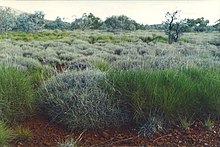Triodia (plant)
| Triodia | |
|---|---|

| |
| Triodia pungens (green) and Triodia basedowii (blue-grey) | |
| Scientific classification | |
| Kingdom: | Plantae |
| Clade: | Tracheophytes |
| Clade: | Angiosperms |
| Clade: | Monocots |
| Clade: | Commelinids |
| Order: | Poales |
| Family: | Poaceae |
| Subfamily: | Chloridoideae |
| Tribe: | Cynodonteae |
| Subtribe: | Triodiinae |
| Genus: | Triodia R.Br. (1810) |
| Synonyms[1][2] | |
| |
Triodia is a large genus of
A multiaccess key (SpiKey) is available as a free application for identifying the Triodia of the Pilbara (28 species and one hybrid).[6]
Description
Triodia species are
Uses
Spinifex has had many traditional uses for
The species Triodia wiseana is used for building shelters; bunched together it is used for trapping fish against creek beds. It is called baru in the languages of the Yindjibarndi and Ngarluma people; the English term is hard spinifex.[8]

Triodia nanofibres have been used to reinforce rubber and latex products. As of 2023, a Brisbane-based company has raised funds to develop medical gels from spinifex resin.[9]
Species
Species currently include:[10][11]
- Triodia acutispicula Lazarides
- Triodia aeria Lazarides
- Triodia angusta (Burbidge, N.T)
- Triodia aristiglumis (Lazarides) Lazarides
- Triodia aurita Lazarides
- Triodia barbata R.L.Barrett & M.D.Barrett
- Triodia basedowii E.Pritz. – buck spinifex
- Triodia biflora Lazarides
- Triodia bitextura Lazarides
- Triodia brizoides (Burbidge, N.T)
- Triodia bromoides (F.Muell.) Lazarides
- Triodia bunglensis (S.W.L.Jacobs) Lazarides
- Triodia bunicola (S.W.L.Jacobs) Lazarides – southern porcupine grass
- Triodia burbidgeana S.W.L.Jacobs
- Triodia bynoei (C.E.Hubb.) Lazarides
- Triodia caelestialis G.Armstr.
- Triodia claytonii Lazarides
- Triodia compacta (Burbidge, N.T) S.W.L.Jacobs
- Triodia concinna (Burbidge, N.T)
- Triodia contorta (Lazarides) Lazarides
- Triodia cremmophila R.L.Barrett & M.D.Barrett
- Triodia cunninghamii Benth.
- Triodia danthonioides (F.Muell.) Lazarides
- Triodia desertorum (C.E.Hubb.) Lazarides
- Triodia dielsii (C.E.Hubb.) Lazarides
- Triodia epactia S.W.L.Jacobs
- Triodia fissura Barrett, Wells & Dixon
- Triodia fitzgeraldii C.A.Gardner ex N.T.Burb.
- Triodia helmsii (C.E.Hubb.) Lazarides
- Triodia hubbardii (Burbidge, N.T)
- Triodia inaequiloba (Burbidge, N.T)
- Triodia integra Lazarides
- Triodia intermedia Cheel – winged spinifex
- Triodia inutilis (Burbidge, N.T)
- Triodia irritans R.Br. – porcupine grass
- Triodia lanata J.M.Black
- Triodia lanigera Domin
- Triodia latzii Lazarides
- Triodia longiceps J.M.Black
- Triodia longiloba Lazarides
- Triodia longipalea Lazarides
- Triodia marginata (Burbidge, N.T)
- Triodia melvillei (C.E.Hubb.) Lazarides
- Triodia microstachya R.Br.
- Triodia mitchellii Benth. – buck spinifex
- Triodia molesta (Burbidge, N.T) – porcupine grass
- Triodia pascoeana B.K.Simon
- Triodia plectrachnoides (Burbidge, N.T)
- Triodia plurinervata (Burbidge, N.T)
- Triodia procera R.Br.
- Triodia prona Lazarides
- Triodia pungens R.Br. – gummy spinifex
- Triodia racemigera C.A.Gardner
- Triodia radonensis S.W.L.Jacobs
- Triodia rigidissima (Pilg.) Lazarides
- Triodia roscida (Burbidge, N.T)
- Triodia salina Lazarides
- Triodia scariosa (Burbidge, N.T) – porcupine grass
- Triodia schinzii (Henrard) Lazarides
- Triodia scintillans B.M.Anderson & M.D.Barrett 2017[12]
- Triodia secunda (Burbidge, N.T)
- Triodia spicata (Burbidge, N.T)
- Triodia stenostachya Domin
- Triodia stipoides (S.W.L.Jacobs) Crisp & Mant
- Triodia tomentosa S.W.L.Jacobs
- Triodia triaristata Lazarides
- Triodia triticoides C.A.Gardner
- Triodia uniaristata (Lazarides) Lazarides
- Triodia vella Lazarides
- Triodia wiseana C.A.Gardner
Formerly included species
Numerous species once considered members of Triodia have been reassigned to other genera, including: Austrofestuca, Chascolytrum, Danthonia, Dasyochloa, Deschampsia, Diplachne, Disakisperma, Erioneuron, Gouinia, Graphephorum, Leptocarydion, Notochloe, Plinthanthesis, Poa, Puccinellia, Rytidosperma, Scolochloa, Spartina, Torreyochloa, Trichoneura, Tridens, Triplasis, Tripogon, and Vaseyochloa.[13]
See also
References
- ^ doi:10.1071/SB96012.
- ^ "Plants of the World Online". kew.org. Retrieved 3 July 2023.
- ^ Watson, L., and Dallwitz, M.J. 1992 onwards. The grass genera of the world: descriptions, illustrations, identification, and information retrieval; including synonyms, morphology, anatomy, physiology, phytochemistry, cytology, classification, pathogens, world and local distribution, and references. Version: 28 November 2005
- ^ "Special spinifex". Bush Heritage Australia. Retrieved 16 March 2020.
- Parks Australia. Retrieved 16 March 2020.
- ^ M.D. Barrett, B.M. Anderson, K.R.Thiele (2017-06-05). "SPIKEY: An interactive key to Triodia spinifex grasses of the Pilbara, Western Australia Version". Welcome to Identic. Retrieved 2020-05-02.
{{cite web}}: CS1 maint: multiple names: authors list (link) - ^ "Our Artists". Tjanpi Desert Weavers. 7 January 2019. Retrieved 27 December 2022.
- ^ Burndud (1990). Wanggalili; Yinjibarndi and Ngarluma Plants. Juluwarlu Aboriginal Corporation. p. 17.
- ^ "Medical gels made from spinifex grass to provide 'safer' treatments, jobs for Indigenous Australians – ABC News". amp.abc.net.au. Retrieved 2023-03-09.
- ^ "Triodia". The Plant List. Retrieved 25 March 2015.
- ^ Australia, Atlas of Living. "Triodia". bie.ala.org.au. Retrieved 19 January 2019.
- doi:10.1071/SB17011.
- ^ "Kew World Checklist of Selected Plant Families". kew.org. Retrieved 19 January 2019.
